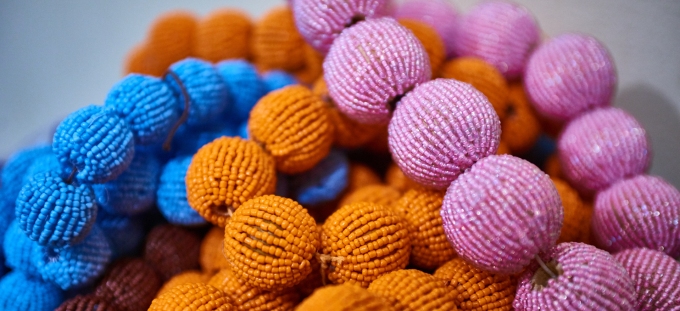CJS Sales Lost Lease After 50 yrs.
The Space We had Planned To Move Into Fell Thru...
We Are Still Liquidating At Our Current Location Thru End Of Feb While Trying To Figure Out A New Plan. Thank You For Your Support During This Difficult Time! We Will Keep You Posted As Soon As We Figure Things Out.
CJS Sales: Crafts, Jewelry, Supplies (Vintage Warehouse)
vintage closeout craft and jewelry supplies: rhinestones, beads, stones, findings, filigree,Swarovski, etc. [We buy: closeouts, people going out of business, liquidations, mixed lots, stuff no one else wants]. It is a warehouse and unless you know what you are looking at it can be very overwhelming! Wholesale only ! www.cjssales.com
Tuesday, January 31, 2017
CJS Sales' New Space Fell Thru...Still Liquidating At Current Location Thru End Feb While Figuring Out New Plan
Labels:
accessories designer,
beading supplies,
CJS,
cjs_sales,
crafts,
Found Objects,
Garment District,
jewelry,
jewelry designer,
jewelry supplies,
Made In NYC,
steampunk,
upcycle,
Vintage Warehouse
Location:
16 W 36th St, New York, NY 10018, USA
Saturday, November 19, 2016
Urban Made Project - CJS SALES TREASURE TROVE FOR THE VINTAGE AND THE UNSUAL - BY: NICOLE LAU Photographed by Nina Duncan [repost]
TREASURE TROVE FOR THE VINTAGE AND THE UNSUAL [Repost from
Carl and Elyse Schimel specialize in the vintage and the unusual. Their warehouse, CJS Sales, is stacked floor to ceiling with boxes of vintage deadstock jewelry and accessory making components. The father and daughter team opened the business in 2002 and is called a treasure trove by many designers not only because of their magnificent finds but because they literally must dig for their wares.
Buyers who shop at CJS Sales know the drill. It is not a place to look for a specific item, rather it is a place to become inspired by the items they unearth.
“One of the things CJS is really set up to do is to be a designer quarry,” says Elyse. “Even if somebody is producing overseas, they come here, get inspired for their next collection, make their samples, and figure out what their next big masterpiece is going to be.”

A MUSEUM TO SHOP IN
Elyse and Carl amass goods to fill their warehouse from fire sales. They’ll buy an entire factory or business closing out or liquidating excess inventory way below market prices such as crystal parts from a chandelier store or Swarovski rhinestones from a rhinestone factory. Those savings are passed on to their customers who receive vintage pieces at prices unmatched anywhere else. The majority of the merchandise is sold by the pound, like their vintage stones, although select items are sold by the piece, pack, or box depending on how the item is originally packaged.
Conveniently located next to a parking garage, designers sometimes come with trucks, dig for days on end, and walk out with $100,000 worth of vintage merchandise to resell or rework, giving the items a second life.
In another light, CJS Sales can be thought of as a museum, an archive of the jewelry and accessory industry, because the contents of each room offers a history lesson. There is pressed glass from the 1920s art deco period, some from occupied Japan and others from West Germany. Occasionally items can be dated based on the packaging. If a box says Czecho—Slovakia, its contents would be from 1918 to 1938. If it says Czechoslovakia, it would be 1938 to 1983, and CzechRepublic, 1983 and later. Similarly, their vintage Swarovski crystals, sold by the pound, would read SK Swarovski or DS Swarovski.
Also in the warehouse are West German vintage plastic (lucite), bakelite (a synthetic plastic that became popular in the 1920s and 1930s to make jewelry), cameos, and ebony wood to name a few other offerings. One entire room is filled with finished vintage deadstock which is popular among costume designers from period movie sets because the easiest way to dress the extras is through accessories, belts, earrings, and other jewelry pieces from the decade.
It is common for designers to climb on top of boxes to pick out a bag of venetian seed beads or walk on tangled piles of vintage chain to get to their next excavation site. But the rule at CJS Sales is, if you hurt yourself, you can’t come back. (No one has yet.)
By the entrance of the warehouse are high-end finished vintage jewelry, some with hang tags and earring display cards bearing the company name Kim Craftsmen in gold lettering. CJS Sales occupies the entire 2nd floor of 16 W. 36th Street but from 1950 to 1997, it was the showroom for Kim Craftsmen, Carl’s former jewelry empire.
Conveniently located next to a parking garage, designers sometimes come with trucks, dig for days on end, and walk out with $100,000 worth of vintage merchandise to resell or rework, giving the items a second life.
In another light, CJS Sales can be thought of as a museum, an archive of the jewelry and accessory industry, because the contents of each room offers a history lesson. There is pressed glass from the 1920s art deco period, some from occupied Japan and others from West Germany. Occasionally items can be dated based on the packaging. If a box says Czecho—Slovakia, its contents would be from 1918 to 1938. If it says Czechoslovakia, it would be 1938 to 1983, and CzechRepublic, 1983 and later. Similarly, their vintage Swarovski crystals, sold by the pound, would read SK Swarovski or DS Swarovski.
Also in the warehouse are West German vintage plastic (lucite), bakelite (a synthetic plastic that became popular in the 1920s and 1930s to make jewelry), cameos, and ebony wood to name a few other offerings. One entire room is filled with finished vintage deadstock which is popular among costume designers from period movie sets because the easiest way to dress the extras is through accessories, belts, earrings, and other jewelry pieces from the decade.
It is common for designers to climb on top of boxes to pick out a bag of venetian seed beads or walk on tangled piles of vintage chain to get to their next excavation site. But the rule at CJS Sales is, if you hurt yourself, you can’t come back. (No one has yet.)
By the entrance of the warehouse are high-end finished vintage jewelry, some with hang tags and earring display cards bearing the company name Kim Craftsmen in gold lettering. CJS Sales occupies the entire 2nd floor of 16 W. 36th Street but from 1950 to 1997, it was the showroom for Kim Craftsmen, Carl’s former jewelry empire.
THE ERA OF KIM CRAFTSMEN
When Carl and his brother Marty started Kim Craftsmen in 1950, fashion was completely controlled. The population was searching for a way to express themselves and they couldn’t do it by the fashion in the department stores. If a girl wanted pierced ears, she couldn’t get it at Macy’s or Gimbels. But she could in Greenwich Village because it was liberal. Even the coffee they served was in a foreign name like espresso and cappuccino, which was unheard of at the time. That was the market the brothers catered to.
Throughout the fifty years, Kim Craftsmen made accessories that were attention-grabbing in style and expressed the wearer’s desired identity. Their caged stone necklaces, one of their early creations, was popular for decades. Hand-bent metal wire encased a stone of a different color, size, and shape and allowed women to choose the unique design of their preference. Also in the 1950s, they produced a line of small pierced earrings for rebellious girls wanting to differentiate themselves from their parents’ generation who still wore clip-on and screw back earrings.
In the late 1960s, the brothers were on the forefront of body jewelry. They designed oversized rings and Cleopatra style wristlets along with more daring pieces such as metal bras with opal nipples and chainmail metal vests which were used to dress department store mannequins and resulted in an influx of letters from appalled consumers. Although the body jewelry was not intended for general public wear, it established a look to emulate and women would buy a toned-down version of the wristlet or copper ring on display. Today, the pieces are collectables.
For the first fifteen years, Kim Craftsmen sold their accessories on the street to local college students, visitors to New York, the “weekend bohemian girls,” and to boutiques because department stores focused on older, more established clientele with a disposable income. But after the Schimel bothers established a loyal customer following, the department stores used them as a leader to bring in the junior market.
Kim Craftsmen was one of the first to use in-store kiosks to attract young women into the department stores and make them feel welcomed. Using this marketing technique, department stores sold about 1,000 pairs of their earrings a day. At around $3 a pair, the sales generated a revenue of $3,000, an amount higher than the rest of the entire jewelry department combined.
Carl and Marty didn’t have any formal design training but took naturally to metalwork. They learned from trial and error and as the business grew, they trained each of their 300 employees as quality craftsmanship was extremely important. Kim Craftsmen filled six and a half floors of the building and when they stopped production in 1997, they had made over 100 million pieces of jewelry.
Throughout the fifty years, Kim Craftsmen made accessories that were attention-grabbing in style and expressed the wearer’s desired identity. Their caged stone necklaces, one of their early creations, was popular for decades. Hand-bent metal wire encased a stone of a different color, size, and shape and allowed women to choose the unique design of their preference. Also in the 1950s, they produced a line of small pierced earrings for rebellious girls wanting to differentiate themselves from their parents’ generation who still wore clip-on and screw back earrings.
In the late 1960s, the brothers were on the forefront of body jewelry. They designed oversized rings and Cleopatra style wristlets along with more daring pieces such as metal bras with opal nipples and chainmail metal vests which were used to dress department store mannequins and resulted in an influx of letters from appalled consumers. Although the body jewelry was not intended for general public wear, it established a look to emulate and women would buy a toned-down version of the wristlet or copper ring on display. Today, the pieces are collectables.
For the first fifteen years, Kim Craftsmen sold their accessories on the street to local college students, visitors to New York, the “weekend bohemian girls,” and to boutiques because department stores focused on older, more established clientele with a disposable income. But after the Schimel bothers established a loyal customer following, the department stores used them as a leader to bring in the junior market.
Kim Craftsmen was one of the first to use in-store kiosks to attract young women into the department stores and make them feel welcomed. Using this marketing technique, department stores sold about 1,000 pairs of their earrings a day. At around $3 a pair, the sales generated a revenue of $3,000, an amount higher than the rest of the entire jewelry department combined.
Carl and Marty didn’t have any formal design training but took naturally to metalwork. They learned from trial and error and as the business grew, they trained each of their 300 employees as quality craftsmanship was extremely important. Kim Craftsmen filled six and a half floors of the building and when they stopped production in 1997, they had made over 100 million pieces of jewelry.
THE SECRET TO SUCCESS
The skill set that made Carl successful throughout the 50 years is the same skill set he used in establishing CJS Sales with his daughter. Success, according to Carl, is not based on the timeframe you are in but how you interpret the market of that timeframe and satisfy that particular market. Similar to how Kim Craftsmen found a niche within the younger generation and gave them what they wanted, CJS Sales recognizes the need of the designers and supplies them with the materials to create.
Designers will not go to Michael’s or Jo-Ann Fabrics and Crafts because those stores are meant for hobbyists. They could possibly seek online vendors but would prefer not to because they want to feel the product and understand its characteristics which can’t be realized from a digital image. Carl uses the example of a new a car to explain the importance of in-person purchases.
“Why don’t they go online? It’s the same reason a guy goes to buy a car. He comes in the showroom to check the tires. You got a picture of a car and it’s a beautiful champagne mist, gold car. It’s another thing when you go in and look at it. It reflects light differently, it has a different intensity… [Designers] come to us because if I send them a picture of the item, they can’t get the depth of the item exactly. Now this is extremely important to a designer. When you are talking to a designer, it is how they view it, how it looks to them.”
A designer may determine that the turquoise cabochon is alright but the green isn’t. Or that the rhinestone’s purple color actually looks deeper than depicted in the photograph. It is this knowledge of how the design industry operates, in addition to the quality items they stock, that has made CJS Sales a destination location.
Designers will not go to Michael’s or Jo-Ann Fabrics and Crafts because those stores are meant for hobbyists. They could possibly seek online vendors but would prefer not to because they want to feel the product and understand its characteristics which can’t be realized from a digital image. Carl uses the example of a new a car to explain the importance of in-person purchases.
“Why don’t they go online? It’s the same reason a guy goes to buy a car. He comes in the showroom to check the tires. You got a picture of a car and it’s a beautiful champagne mist, gold car. It’s another thing when you go in and look at it. It reflects light differently, it has a different intensity… [Designers] come to us because if I send them a picture of the item, they can’t get the depth of the item exactly. Now this is extremely important to a designer. When you are talking to a designer, it is how they view it, how it looks to them.”
A designer may determine that the turquoise cabochon is alright but the green isn’t. Or that the rhinestone’s purple color actually looks deeper than depicted in the photograph. It is this knowledge of how the design industry operates, in addition to the quality items they stock, that has made CJS Sales a destination location.
ENTREPRENEURSHIP & OLD GARMENTO HUMOR
When Elyse visited her father at the factory growing up, she didn’t sit in the corner and read, she participated. At the age of nine, Elyse remembers working on the assembly line, painting the jewelry and learning how to design. When she was getting her doctorate degree, Carl thought she needed some “busy work” so Elyse began selling Kim Craftsmen merchandise as he liquidated the business. Carl, who started selling on the street at the age of 16, wanted Elyse to learn self-efficacy.
“We’d hear stories about family businesses, someone going to the school and saying, ‘I don’t care if my kid is bright, I don’t want them in calculus. I want them in bookkeeping,’” says Elyse. “Parents come in with their teenage age kid and get them to help with the business.”
Growing up, the emphasis was on learning by doing, to prepare for the workforce by encouraging kids to get a job. Elyse is a clinical psychologist but believes she would have been as successful in establishing CJS Sales with her father coming out of high school because she worked in the family business. The norm now is for everyone to attend college but Elyse argues that college isn’t right for everyone.
Five years ago, one designer was buying finished goods to resell online and making $200,000 in profit. She dropped out of college because there was nothing more to learn that she didn’t already do herself. Carl was already profitable by the time he enrolled in NYU Stern. A job is to support yourself and make money, but it is also the best form of education.
“We’d hear stories about family businesses, someone going to the school and saying, ‘I don’t care if my kid is bright, I don’t want them in calculus. I want them in bookkeeping,’” says Elyse. “Parents come in with their teenage age kid and get them to help with the business.”
Growing up, the emphasis was on learning by doing, to prepare for the workforce by encouraging kids to get a job. Elyse is a clinical psychologist but believes she would have been as successful in establishing CJS Sales with her father coming out of high school because she worked in the family business. The norm now is for everyone to attend college but Elyse argues that college isn’t right for everyone.
Five years ago, one designer was buying finished goods to resell online and making $200,000 in profit. She dropped out of college because there was nothing more to learn that she didn’t already do herself. Carl was already profitable by the time he enrolled in NYU Stern. A job is to support yourself and make money, but it is also the best form of education.
In addition to acquiring her father’s strong work ethic, Elyse also picked up an appreciation for the old garment industry’s uncensored humor. She readily shares the time when her father told the drag queen who shops at the warehouse, “I tell everyone that the best set of tits comes with a nice pair of balls!” Elyse’s and Carl’s tenacity and discipline with a touch of jocularity make them ideal business partners.
Elyse lives in Florida but returns to New York once or twice a month when a big customer is scheduled to visit. She would watch the business through cameras that would stream live feed to her phone and call the office to ask her father, why are you in the back doing that? Or to remind him that he forgot to open the gate. One day, the camera feed mysteriously went out. Carl later said to her, “I’ve been in business for seventy years. I don’t need you to manage me from Florida!”
Author’s Note:
Author’s Note:
One week after the interview, before this profile was completed, Carl was told his lease would not be renewed after 66 years as a tenant at 16 W 36th Street. Carl, who is 82, and continues to work 6 days a week, (only allowing himself one vacation a year to go fishing) hoped to spend the remainder of his career in the building he started in but was not given an option to negotiate a new contract. The building managers prefer to have a different (non-garment related) clientele. This occurrence is unfortunately not uncommon in New York’s Garment District. 2013 was the first year the number of non-garment related business outnumbered garment-related businesses and that number continues to rise. In the past three years alone, 13 of Carl’s friends have gone out of business.
Labels:
Beads,
Carl Schimel,
CJS,
CJS Sales,
closeouts,
designer,
emerging,
Garment District,
jewelry,
jewelry supplies,
made in NY,
Made In NYC,
Nicole Lau,
Nina Duncan,
Urban Made Project,
Vintage Warehouse
Location:
16 W 36th St, New York, NY 10018, USA
Thursday, October 27, 2016
Vintage Jewelry Making and Beading Supplies Treasure Trove
Vintage Jewelry Making and Beading Supplies Treasure Trove: Vintage jewelry making supplies create unique finished pieces of wearable art. Join Tammy Jones and Tammy Honaman on their latest adventure in NYC!
Monday, October 17, 2016
"Vintage Jewelry Making and Beading Supplies Treasure Trove" by Tammy Honaman (repost from Beading Daily)
Vintage Jewelry Making and Beading Supplies Treasure Trove
[repost from Beading Daily] October 17, 2016Tammy Honaman
On a Vintage Jewelry Making Adventure
At the close of Bead Fest this past August, Tammy Jones, JewelryMakingDaily.com editor, and I had the pleasure of traveling to New York City. We took a train in to the City to visit CJS Sales: Craft Jewelry Supply, home of vintage jewelry making and beading supplies. Our mission was to spend time with Carl and Elyse Schimel, the father daughter-duo behind CJS and to shop!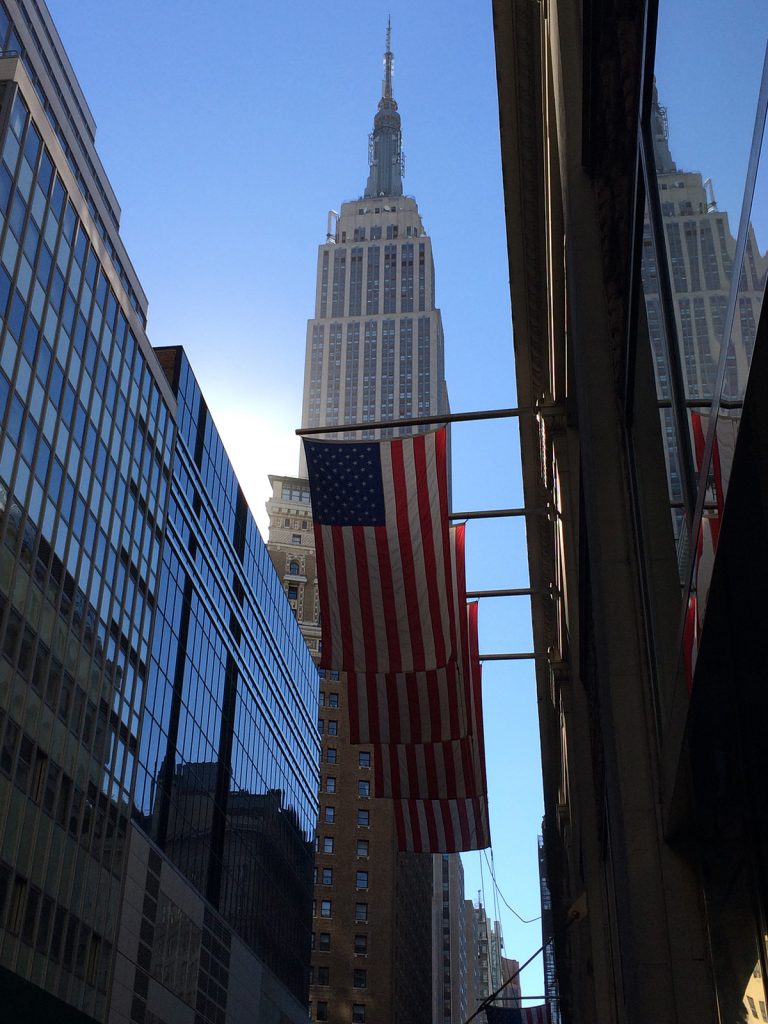

If you’ve never been to CJS, please believe me when I tell you, it’s like being inside a huge treasure chest. If you remember the Little Rascals episode where they sneak off to the cave to find the hidden treasure, it’s kind of like that. Unlike the cave and unhappy giant, you travel to CJS via the elevator and exit at the second floor. Upon the doors opening, you’re immediately greeted by a warm smile, a sturdy box to fill, and your first room filled with vintage jewelry-making materials. If you’re a new visitor, you’ll also be asked some information so they can verify you’re in the right place, have wholesale buying credentials, and have an idea of what’s in store. Immediately in front of you is floor to ceiling, shelves filled with Czech glass cabochons, glass beads, and a glimpse at a wall of Swarovski crystals.
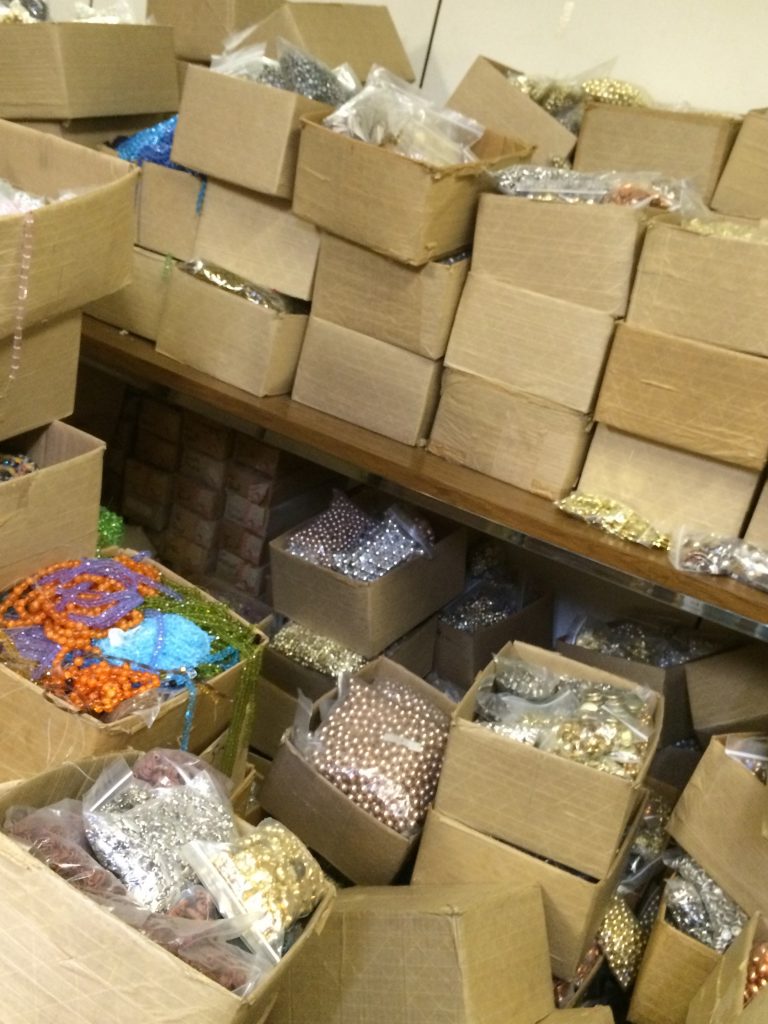
Diving Into the Vintage Jewelry Making Materials
Before jumping right into searching (aka treasure hunting), Elyse, our gracious host, offered a more formal tour.
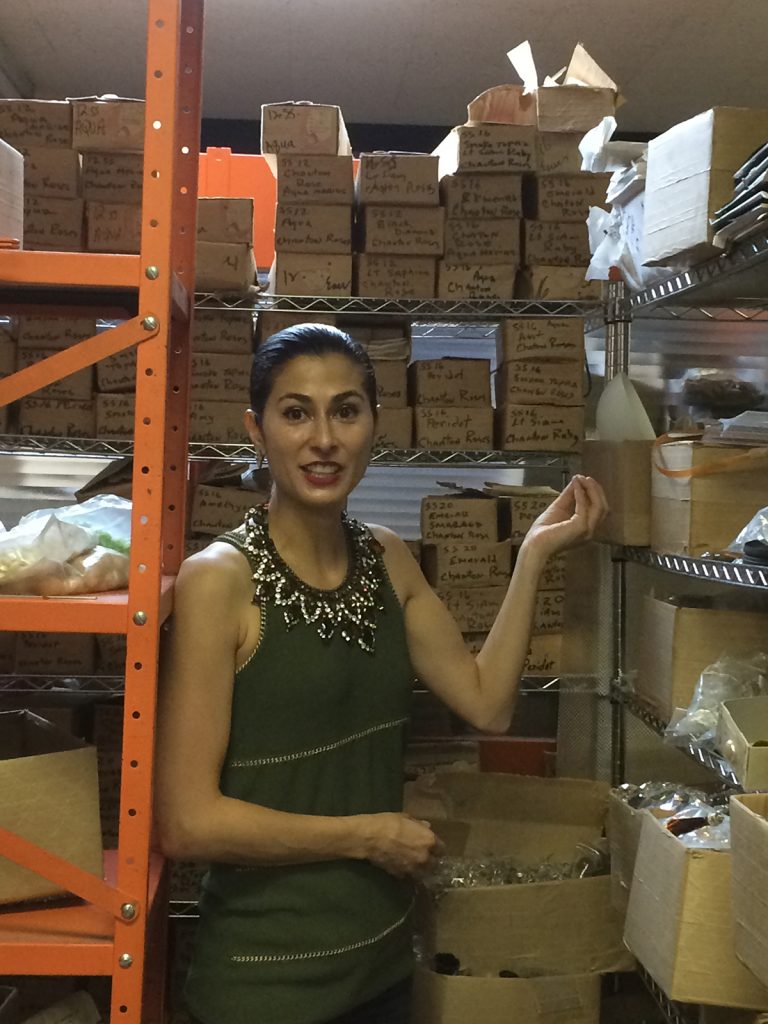
First on our vintage jewelry making materials tour, we pass the pearl room (filled with real and faux pearls. If you’re thinking about a trip, keep in mind, it’s up to you to know which pearl is which. And not everyone can take Tammy Jones along with them, so be prepared!).
After the pearl room came one of my favorite spaces, the metals room. A never-ending pool of amazing vintage jewelry making goodness, and all materials you can turn into new treasures. Again, it’s up to you to know what you’re looking at – copper, brass, plated, etc.
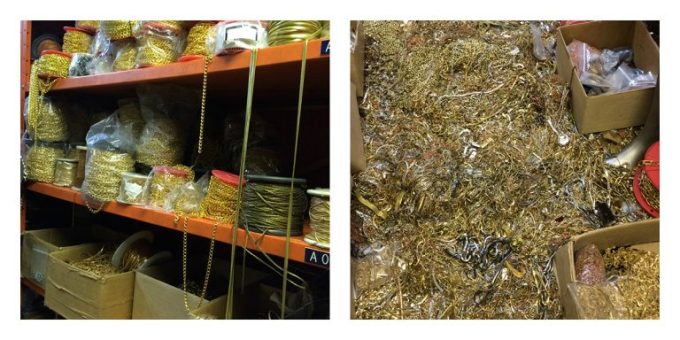
A Bit of Jewelry and Accessories History
Here we pause, and Elyse takes time to share more of the history of CJS with us. She explained the evolution of the company, from her father being a founder of Kim Craftsmen, a leading accessories manufacturer for over 50 years; his being a jewelry designer in his own right; to his near retirement before CJS became all it is today. Elyse also shared her evolution from Wharton college graduate, to her psychology doctorate, how she came to help her dad throughout her time in school, to becoming his partner at CJS Sales.
Elyse also offers this about CJS: “CJS is a designer’s quarry. By selling high-quality vintage jewelry making materials we can help bead shops and resellers have things they will be able to design with. And so they can compete with mass producers from overseas. Glass marcasite from the 20s can’t easily be copied within a good margin, so CJS would be a great source for what you need to design with versus having to source the vintage materials yourself.”
Making Our Way Through CJS Sales
As we progress through the metals rooms, we enter the “naturals” room where you can find bone, wood, and shell materials. Soon after we’re faced with lots of decisions. Plastics of all kinds – beautiful plastics – to chandelier parts. A lot of chandelier parts. Just ahead is the room of chains.
As we make our way back to the front of CJS we pass a rack of shelves that holds beautiful Swarovski sew-on stones. Not only are these pretty, they’re also extra special as Elyse had some of these stitched onto her wedding gown (along with other amazing treasures found at CJS).
A Seed Bead Mecca
Walking toward our next corner of the space, we pass another wall of crystal amazingness. Then we find ourselves in the seed bead room. This was definitely like climbing through a tunnel into a huge cave opening. And wow! There was no shortage of vintage beads here! Vintage Italian bugle beads, vintage Czech striped beads, mercury-glass-like Czech glass seed beads, and boxes and boxes of so much more.
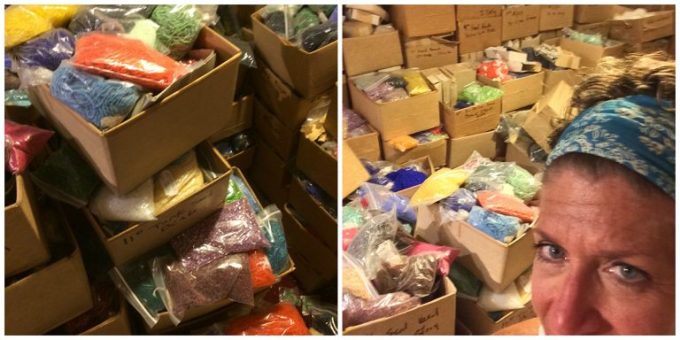
One funny story I’ll add. While searching for striped seed beads, Elyse came into the room to help me. This being her place, she was much more comfortable hefting and moving boxes. Once I saw her method, soon we were both moving and hefting boxes in search of the stripe seed beads I was searching for. Once we found some (a lot, actually), Elyse moved on to greet new customers and see if she could help Tammy. Soon after, one of our newly formed towers of seed bead boxes tipped over, blocking my exit from the room (back to the cave and the little rascals!). This was an easy fix and with some rearranging all was righted, but it was one of those moments you wish you had captured on video!
The Man Behind the Brand, The Master of Vintage Jewelry Making Supplies
Before finishing up our tour, Elyse was very kind to share with us her father’s office. We didn’t get into the space but she gave us a peek. It’s definitely one of those rooms you wish you had a few days to spend in as you know it is the space of a genius, and likely where Carl has saved things that are near and dear to him.

Another element of this tour was the knowledge the current warehouse would not be the Schimel’s forever home. They recently lost their lease. The building’s new owners have different plans for the space. The Schimels are currently liquidating to become more nimble and able to move to their new location. If you are a designer, the Schimels want to welcome you to their place. They love to share all they’ve acquired in the hopes of helping designers be able to create with quality materials. And to give them access to materials otherwise not available to mass producers. They want to give jewelry designers an edge over the competition; the heart of their mission all these years.
Off on Our Next Adventure
Eventually, Tammy and I had to bid our farewells and did so with the promise to return. On our train ride home, I shared some of my finds with Tammy and together we agreed that much of what I collected would be great for designs found in our Bead Embroidery with the Masters Collection. I can see it now, pearl cabochon surrounded by the glowing Italian bugle beads, Swarovski sew-on stones, and beautiful collection of Czech seed beads.

If you’ve been to CJS and seen the vintage jewelry making materials haven, please add a comment and share your story and best finds. If you were one of the lucky ones to secure this vintage collection of beads and beading materials (available while supplies last), curated during this amazing adventure, be sure to stop back and upload a picture to our member gallery.
Thank you Mr. Schimel and Elyse. You gave the 2 Tammys a great experience, and one we’ll always remember. And, with all we procured, we have lots of great materials to work into unique wearable pieces of new jewelry for a long time.
Yours in creativity,

Labels:
beading daily,
beading supplies,
Beads,
CJS,
CJS Sales,
closeout jewelry findings,
crafts,
jewelry,
jewelry designer,
jewelry making,
supplies,
tammy honaman,
Vintage,
vintage jewelry components,
Vintage Warehouse
Location:
16 W 36th St, New York, NY 10018, USA
Thursday, July 14, 2016
17 Apart: Secret New York City Jewelry Supply Warehouse: CJS...
17 Apart: Secret New York City Jewelry Supply Warehouse: CJS...: I promised a post about one of my go-to wholesale jewelry supply warehouses in NYC and today I'm giving you the full run down! Some of...
Monday, June 13, 2016
Tuesday, June 30, 2015
Modern Heirloom Jewelry for the Bride (Oh My!)
Pink Dogwood Jewelry thank you for the shout out to CJS Sales: Crafts, Jewelry, Supplies in Southern Living Magazine!
reblogged below
Modern Heirloom Jewelry for the Bride (Oh My!)
 Nan Faulkner is the former pharmaceutical rep/turned momtraprenuer (with creative ability that most of us only dream about). She takes vintage costume jewelry and rewires it, designing it into relevant accessories.
Nan Faulkner is the former pharmaceutical rep/turned momtraprenuer (with creative ability that most of us only dream about). She takes vintage costume jewelry and rewires it, designing it into relevant accessories.
reblogged below
Modern Heirloom Jewelry for the Bride (Oh My!)
Pink Dogwood Jewelry does something unique: they re-imagine vintage jewelry into something you want to wear now.
 Nan Faulkner is the former pharmaceutical rep/turned momtraprenuer (with creative ability that most of us only dream about). She takes vintage costume jewelry and rewires it, designing it into relevant accessories.
Nan Faulkner is the former pharmaceutical rep/turned momtraprenuer (with creative ability that most of us only dream about). She takes vintage costume jewelry and rewires it, designing it into relevant accessories.For a gift, it’s easy to find just the right thing. For a bride, Pink Dogwood supplies tear-worthy, fairy magic.
Though Pink Dogwood repurposes vintage components into modern necklaces, earrings and bracelets, Nan also takes on custom assignments.
Do you have Grandma’s broach and want it to be the statement clasp on pearls for your wedding? Done.

How about a rhinestone shoe clip into a bracelet? No problem.
Want matching jewelry for your bridal party? Nan can make that happen from her vast collection consisting of tens of thousands of pieces, all vintage. She frequents flea markets and estate sales but also makes the pilgrimage to New York’s garment district to stock up at CJS Sales Limited, a specialty wholesaler of vintage and antique components.
For brides, Nan is fond of old cameos, pearls and clear or ombre rhinestones. She envisions vintage jewelry as something entirely new, and undeniably wearable. “Brides now are asking for statement necklaces for their weddings,” she says. “Because antique and vintage have come roaring back into everything from home décor to fashion, brides are willing to up the ante and wear something significant at their neckline. It’s striking and makes a beautiful, memorable photo.”
And what about those crazy clip earrings? If they are set right, Nan will take them apart and rewire them into a modern fitting applying industrial epoxy and affixing new hardware.

Though her goal is to do as little damage as possible, if a piece is degrading, she can strip it down to its beads or pearls and start from scratch.
Necklaces retail for $45-70. Custom work ranges $60-120. Best of all, 100% of custom work is sized to the bride’s measurements and styling.
Find Nan Faulkner’s latest work online atpinkdogwoods.com (or if you’re in my hometown stop by Greenville’s UrbanDigs).
Subscribe to:
Comments (Atom)


